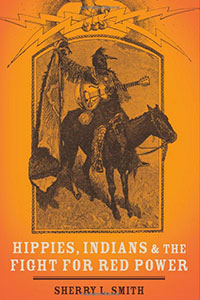By MARTHA MINOW
Review of HIPPIES, INDIANS AND THE FIGHT FOR RED POWER, by Sherry L. Smith
Oxford University Press, 2012
View UNLIKELY ALLIANCES FROM WOODSTOCK TO WOUNDED KNEE .pdf
"Pride," a 2014 award-winning independent film, tells the true story of the unlikely alliance between lesbian and gay activists and striking British coal miners in 1984. The National Mineworkers Union feared negative press and declined help offered by a London-based group of lesbian and gay activists. The activists took their financial and moral support directly to a small Welsh mining village, and began an alliance of mutual support, including participation by the National Mineworkers in a gay pride march.
Sherry L. Smith examines another true but unlikely alliance in Hippies, Indians and the Fight for Red Power. Here, members of the American counterculture during the 1960s and 1970s offered help and collaboration as American Indians struggled for political and legal power and recognition. This nuanced analysis underscores the central role of Indian activists and the often ignorant and inconsistent contributions of non-Indians, but nonetheless shines light on the efforts of hippies, Quakers, and other non-Indians in the uphill struggle for fishing rights, land claims, and self-determination by Indian tribes.
Organized in chapters that focus on a series of public protest events across North America, the book tracks encounters between Indians and writers, students, actors, and religious congregants who episodically identified with or supported emerging Native American claims to fishing rights, cultural autonomy, and land. Colorful individuals carry the stories. One is Stewart Brand, who later found fame as publisher of the counter-cultural Whole Earth Catalog. Brand discovered in 1963 a group of friendly, funny people through a photography project at the Warm Springs Reservation in Oregon. People who respected and connected with nature resonated with Brand even as he discovered conflicts within the reservation council over future economic development (pp. 45-56). Through his wife, he discovered Indian women speaking with authority and receiving respect. He explored Peyote use. He asserted "America needs Indians" and he promoted books about Indians, as well as books on Zen and Tantric Buddhism and Carlos Castaneda's The Teachings of Don Juan, an account of a Yaqui Indian guide later speculated to be fictional. Brand attracted some 10,000 people to a festival that he created to simulate LSD trips without the drugs, and began to explore ways to mobilize people for causes. Another intriguing figure is Charlie Brown Artman, whose banner against the Vietnam War and habit of pitching a "wigwam" on public land garnered publicity (p. 78).
Smith tracks books and events that brought sympathetic mainstream attention to Indians. Smith might have more clearly explained how precisely such attention was new in content or amount. Even so, Smith effectively shows how direct action by small numbers of Indians – such as occupying Alcatraz Island in San Francisco Bay – elicited aid and sympathy from college students, reporter, celebrities (Jane Fonda, Buffy Sainte-Marie, The Credence Clearwater Revival rock band), and churches, in no small part because Indian causes resonated with countercultural commitments to peace, drug use, environmental protection, and living fully on the land (pp. 84-112).
The book notes the difference between symbolic and material actions (p. 115). It also acknowledges times when the involvement of non-Indians took jobs away, jacked up real estate prices, or triggered violence to the detriment of Indians (p. 135). Non-Indians at times showed naiveté, ignorance, arrogance, and inconstancy. These darker themes ensure that the narrative of cooperation is countered by skeptical tones. The book also largely leaves direct judicial and legislative actions to the background, although it repeatedly examines how public protests from Alcatraz in 1969 to the 71-day siege at Wounded Knee in 1974 pressured public officials all the way to the White House.
As a work of history, Hippies, Indians, and the Fight for Red Power stresses the particular and contingent details of personal encounters and events rather than broad principles or general lessons. Yet relevance to contemporary social and political moments lies in its steady focus on surprising alliances -- and its unblinking questions about them. How did Quakers come to support gun-brandishing Indians (p. 297)? Somehow the country changed its official stance toward Indians from a policy of termination and extinction to a policy of self-determination. Along with legislation, striking judicial decisions advanced respect for Indian sovereignty. Authoring key decisions in this vein at the Supreme Court was Justice Thurgood Marshall, the leader of the legal movement for racial justice. Yet rather than a conception of individual rights "Red Power" pursued group recognition. At times, the advances for tribal autonomy proceeded at the price of equal rights for women, where gender equality and Indian rights conflicted. Law and social change involve unlikely alliances and surprising clashes between likely allies, and both deserve the kind of detailed attention offered in Sherry Smith's work.
MARTHA MINOW is the Morgan and Helen Chu Dean and Professor of Law at Harvard Law School. Her most recent book is The First Global Prosecutor: Promise and Constraints, co- edited with Cora True-Frost and Alex Whiting (forthcoming 2015).

